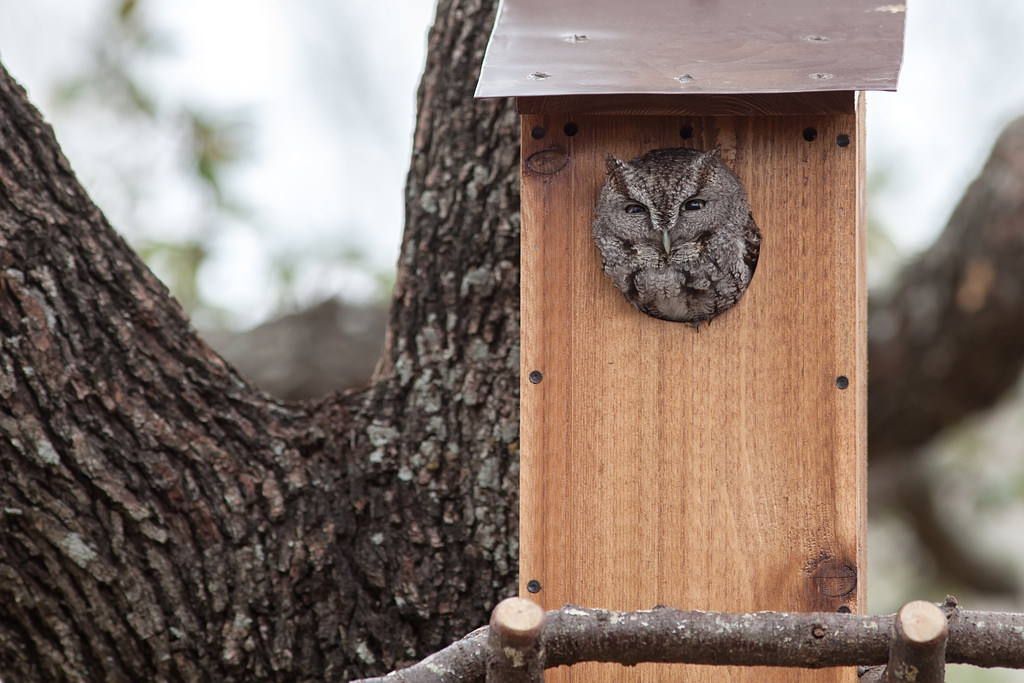Habitat Project: Eastern Screech-owl Boxes
Did you know? Maryland is home to eight species of owls, several of which are year-round residents while others visit during migration. The smallest resident owl in Maryland is the Eastern Screech-owl, which is often under 10 inches in length. Eastern Screech-owls are formidable hunters and are adapted to survive in both suburban and rural areas where the owls quietly pick off rodents and other small mammals with ease. Unlike larger owls, Eastern Screech-owls will readily take to nesting in boxes if the conditions are right.
Eastern Screech-owls begin establishing their territories in mid-February in Maryland and begin nesting in early March. Eastern Screech-owls can be found in small woodlots and are often present near water. Interestingly enough, wood duck boxes can be very attractive to eastern screech-owls. While screech-owls like to nest by clearings, you should place the box away from roads and pathways as the owls can become territorial during nesting.
Like all nest boxes, size and placement are important. For eastern screech-owl nest box plans, you can check out our website here or Cornell’s Nestwatch site here. Alternatively, you can also construct a wood duck box. Adding saw grooves inside the box will assist fledglings with climbing in and out of the box. Eastern Screech-owl boxes should be placed 10-30 feet up in the air either in a live tree or on a pole close to a woodland edge and a natural water source. Because Eastern Screech-owls do not build their own nests, it is best to place 2-3 inches of wood shavings in the bottom of the boxes for nesting materials. Cedar and sawdust should be avoided as nesting materials. To help with drainage, be sure to add a small hole or two to the bottom of the box. Sometimes, adding a second box at least 100 feet away will serve as an alternative nesting site for a pair of owls. It is best to hang boxes by mid-January to allow owls ample time to find the boxes.
Unwanted residents can sometimes take over the abode. Squirrels often will use screech-owl boxe so it is best to place aluminum flashing or vinyl siding over the top and sides of the box. This prevents squirrels from getting ample footing to reach the box. As an alternative, metal flashing can be placed on the tree above and below the box to deter squirrels. In either case, it is important to place the box away from limbs or trees where squirrels can easily jump from to access the box. If squirrels do take up residence, you can either enjoy the new batch of squirrels or remove the nest before the female gives birth.
If you do get owl residents, be sure to give them some space as they raise their young. Also, please consider reporting occupants to the MD-DC Breeding Bird Atlas which is covered in the next HabiChat article. Generally, owls will return to nesting locations year after year. Be sure to clean out the box and replace nesting materials every year, even if you don’t get residents.
Acknowledgements
Ellison, W.G. 2010. Second Atlas of the Breeding Birds of Maryland and the District of Columbia. Baltimore, MD: The Johns Hopkins University Press. 520 pages.
Happy New Year HabiChat fans!
Winter can be a tough time of year for many of our local wildlife species. You can give them a hand by creating habitat and providing natural foods. In this winter edition of HabiChat, learn about Cedar Waxwings, a lovely resident bird that can be found in backyards, as well as our native inkberry holly that provides important cover. In addition, this issue also includes articles on Winter Greens for Wildlife, Eastern Screech Owl Nest Boxes, and how to help with the 3rd Maryland-DC Breeding Bird Atlas.
Winter is also a time for maintenance projects, so don’t forget to clean out and repair nest boxes and prune your shrubs and trees. If you are feeding birds, please also make sure to keep those feeders clean. In addition, water is crucial to many species this time of year. Consider adding a heated bird bath or pet water bowl to your landscape to help local wildlife. If you are looking for fun projects to do with the kids, why not go on a winter safari or make seed wreaths for the birds?
Finally, I am pleased to announce that we have completed the Simple School Wildlife Garden Guide. The guide contains basic information on how to start a school wildlife garden and includes suggested plants and designs for three types of gardens: a monarch garden, a songbird garden, and a pollinator garden. The guide can be found on our Schoolyard Wildlife Habitat page.
Happy Habitats,
Kerry Wixted
Click here to have HabiChat—the quarterly backyard wildlife habitat newsletter from the Wild Acres program—delivered right to your inbox!
In this Issue
Breeding Bird Atlas
Habitat Tip: Winter Greens for Wildlife
Native Animal Profile: Cedar Waxwing
Native Plant Profile: Inkberry



 1-888-373-7888
1-888-373-7888 233733
233733